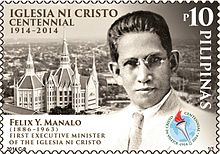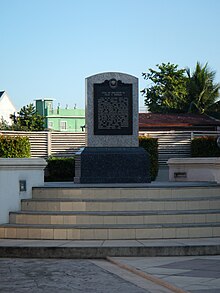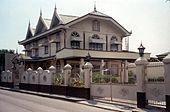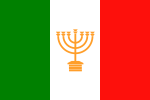In this Philippine name, the middle name or maternal family name is Manalo and the surname or paternal family name is Ysagun.
| SugoFelix Manalo | |
|---|---|
 Manalo on a 2014 stamp of the Philippines Manalo on a 2014 stamp of the Philippines | |
| Title | Executive Minister |
| Personal life | |
| Born | Félix Ysagun y Manalo (1886-05-10)May 10, 1886 Calzada Tipas, Taguig, Manila, Captaincy General of the Philippines, Spanish Empire |
| Died | April 12, 1963(1963-04-12) (aged 76) Quezon City, Philippines |
| Resting place | San Juan Cemetery, Manila, Philippines |
| Spouse |
|
| Children | 7, including Pilar and Eraño |
| Parents |
|
| Other names | Ka Felix, Feles |
| Religious life | |
| Religion | Christianity |
| Denomination | Iglesia ni Cristo |
| Senior posting | |
| Period in office | July 27, 1914 – April 12, 1963 |
| Predecessor | Position established |
| Successor | Eraño G. Manalo |
Felix Manalo (born Félix Ysagun y Manalo; May 10, 1886 – April 12, 1963), also known as Ka Felix, was a Filipino Christian minister who founded Iglesia ni Cristo (INC), a restorationist nontrinitarian Christian denomination in the Philippines officially founded in 1914. Manalo is believed by INC adherents to be the last prophet of God in the final days, sent to reestablish the church that Jesus founded, which they claimed to have fallen into apostasy following the deaths of the apostles. He served as the church's first Executive Minister until his death in 1963, and was succeeded by his son, Eraño Manalo.
Born in a devout Catholic family, Manalo began questioning Catholic teachings during the Philippine Revolution in the 1890s, ultimately converting first as a Methodist in 1904, then as a Seventh-day Adventist in 1911 before he began preaching what was to become the doctrine of the Iglesia ni Cristo at a neighborhood in Santa Ana, Manila, which he formally registered to the Philippine government on July 27, 1914 as a religious corporation. He was seen as the "angel ascending from the East" as mentioned in Revelation 7:2 by his early followers. During his tenure as Executive Minister, he oversaw the church's early growth and rapid expansion following the Japanese occupation of the country during World War II. By the 1950s, Manalo's health had deteriorated, leaving most of his official church duties to his son Eraño. He died of peptic ulcer disease in 1963.
Biography

Manalo was born in Barrio Calzada, Tipas, Taguig, Manila province (now Calzada, Taguig, Metro Manila) on May 10, 1886, the eldest child of Mariano Ysagun and Bonifacia Manalo y Cruz. While records of his baptismal was lost, it is believed that he was christened on May 18, the feast day of Felix of Cantalice, most likely his namesake given the common practice of Catholic Filipino families during that period to name their child after saints whose feast fall on the date of birth or baptismal. Raised to a poor rural family, he received little formal education. His father died when he was two to three years old, from which he began using his mother's last name Manalo.
Manalo began questioning Catholic teachings by the late 1890s. He resided in Manila at his uncle Mariano Borja, a Catholic priest assigned to a local parish in Sampaloc. During this period, Manalo started becoming disillusioned with mainstream Catholic faith and began believing in colorumism, a syncretism of Christian and animist beliefs popular among Filipino peasants during the revolution, making secret trips to Mount Banahaw and Mount San Cristobal in southern Luzon. During the early years of the American period, Manalo became interested in Protestant doctrine that entered the country through American missionaries. In 1904, he became a Methodist, switching among Protestant denominations until 1911, when he became a Seventh-day Adventist pastor. Disagreement with the core doctrine led to his expulsion from the church in 1913. Frustrated with the doctrines of foreign denominations, he soon began personally studying the Bible which culminated in November 1913 when he concluded that a fresh examination of the Bible is needed from a non-Western perspective.
Iglesia ni Cristo

In November 1913, Manalo began a three-day fast and meditation at a friend's house in Pasay, writing his core doctrine. He proposed founding a new church in Asia, which he named "Iglesia ni Cristo" (INC), Tagalog for "church of Christ". He started preaching his doctrine in Punta, a neighborhood in Santa Ana, Manila. Within a month, he had attracted multiple followers. He registered Iglesia ni Cristo at the Philippine government on July 27, 1914 as a religious corporation, the date now officially acknowledged by the INC as its foundation date. Expansion followed as the INC started building congregations in the provinces as early as 1916.
Throughout his lifetime, Manalo is seen by his followers as the ultimate authority on the church affairs, including its theology and bureaucracy, even approving the architectural design of its distinctive churches. His title as the Sugo (transl. Messenger) was legitimized in 1922, after interpreting that Manalo is the "angel from the East" mentioned in Revelation 7:2. Manalo's authority over the church was so pervasive that outsiders termed the church as the Iglesia ni Manalo (transl. Church of Manalo) and its adherents "Manalistas". During its formative years, Manalo and his followers experienced persecution from Catholics, which ranged from stoning to beatings. In 1922, the church lost buildings in Bulacan and Nueva Ecija in a brief rebellion. Despite this, the INC had about 3,000 to 5,000 adherents in 43 or 45 congregations in Manila and six nearby provinces by 1924. By 1936, the INC had 85,000 recruits. This figure grew to 200,000 by 1954. It expanded into the Visayas by 1937, Northern Luzon by 1938, Mindoro by 1940, and Mindanao by 1941. Meanwhile, the INC's first concrete chapel was built in Sampaloc, Manila, in 1948. Adherents fleeing Manila, where the Japanese forces were concentrated during the Second World War, were used for evangelization. As Manalo's health began to fail in the 1950s, his son Eraño started to take leadership of the church.
Death
Manalo's health started to deteriorate in the 1950s. On April 2, 1963, Manalo was confined to hospital for treatment of peptic ulcer disease. Days later, on April 11, doctors performed a surgery on him for his ulcer, from which he didn't recovered from. He died in the early hours of April 12 at the age of 76. Leadership of the church was passed two weeks later to his son, Eraño, who was chosen unanimously by the district ministers as his successor in 1953. His remains were viewed by mourners in San Francisco del Monte, Quezon City. On April 23, he was buried at what was then the central office of the Iglesia ni Cristo in San Juan, Rizal. The local police estimated the crowd at the funeral procession to have been two million, and the rite took five hours.
Legacy
The ministers of the Christian Mission honored him on December 25, 1918, as an outstanding evangelist.
The Genius Divinical College of Manila on Avenida Rizal, a non-sectarian institution headed by Eugenio Guerero, conferred on Felix Manalo the degree of Master of Biblo-Science honoris causa on March 28, 1931.
On July 27, 2007, coinciding with the 93rd anniversary of the Iglesia ni Cristo, the National Historical Institute (NHI) unveiled a marker on his birthplace in Calzada, Taguig, declaring the site as a National Historical Landmark, with the executive director of the institute, Ludovico Badoy, giving remarks. The site is maintained by the INC. On the same year, the Philippine government declared July 27 of every year as "Iglesia ni Cristo Day". On May 10, 2014, coinciding with his 128th birth anniversary, Philpost controversially released a commemorative stamp celebrating the 100th year of the church's registration in the Philippines, which featured a portrait of him against the backdrop of the INC Central Temple. Philpost was sued for allegedly using public funds to support religious groups, reaching the Supreme Court of the Philippines but was dismissed, with the court holding that the stamps acknowledged the Iglesia ni Cristo but did not sponsor it.
The main road in Punta, Santa Ana, Manila, where he first began preaching, is named after him.
Works
- Manalo, Felix Y. (1947). Ang Sulo Sa Ikatitiyak Sa Iglesia Katolika Apostolika Romana [The Torch of Certainty of the Apostolic Roman Catholic Church] (in Tagalog). Quezon City: Ang Pasugo.
Ancestry
| Ancestors of Felix Manalo | |||||||||||||||||||||||||||||||||||||||||||||||||||||||||||||||||||||||||||||||||||||||||||||||||||||||||||||||||||||||||||||||||||||||||||||||||||||||||||||||||||||||||||||||||||||||||||||||||||||||||||||||||||||||||||||||||||||||||||||||||||||||||||||||||||||||||
|---|---|---|---|---|---|---|---|---|---|---|---|---|---|---|---|---|---|---|---|---|---|---|---|---|---|---|---|---|---|---|---|---|---|---|---|---|---|---|---|---|---|---|---|---|---|---|---|---|---|---|---|---|---|---|---|---|---|---|---|---|---|---|---|---|---|---|---|---|---|---|---|---|---|---|---|---|---|---|---|---|---|---|---|---|---|---|---|---|---|---|---|---|---|---|---|---|---|---|---|---|---|---|---|---|---|---|---|---|---|---|---|---|---|---|---|---|---|---|---|---|---|---|---|---|---|---|---|---|---|---|---|---|---|---|---|---|---|---|---|---|---|---|---|---|---|---|---|---|---|---|---|---|---|---|---|---|---|---|---|---|---|---|---|---|---|---|---|---|---|---|---|---|---|---|---|---|---|---|---|---|---|---|---|---|---|---|---|---|---|---|---|---|---|---|---|---|---|---|---|---|---|---|---|---|---|---|---|---|---|---|---|---|---|---|---|---|---|---|---|---|---|---|---|---|---|---|---|---|---|---|---|---|---|---|---|---|---|---|---|---|---|---|---|---|---|---|---|---|---|---|---|---|---|---|---|---|---|---|---|---|---|---|---|---|---|
| |||||||||||||||||||||||||||||||||||||||||||||||||||||||||||||||||||||||||||||||||||||||||||||||||||||||||||||||||||||||||||||||||||||||||||||||||||||||||||||||||||||||||||||||||||||||||||||||||||||||||||||||||||||||||||||||||||||||||||||||||||||||||||||||||||||||||
References
- ^ Suarez, E.T. (July 27, 2008). "Officials celebrate with Iglesia ni Cristo on its 94th anniversary". The Manila Bulletin Online. The Manila Bulletin. Archived from the original on December 2, 2008. Retrieved November 10, 2008.
- Stefon, Matt (January 9, 2025). "Iglesia ni Cristo". Encyclopedia Britannica. Retrieved January 11, 2025.
- ^ Ordinario, Felvir (August 3, 2014). "The Ancestry of Félix Manalo". Lahing Pinoy. Wordpress. Retrieved June 18, 2015.
- ^ Reed, Robert R. (2001). "The Iglesia ni Cristo, 1914–2000. From obscure Philippine faith to global belief system". Bijdragen tot de Taal-, Land- en Volkenkunde. 157 (3). Leiden University: 561–610. doi:10.1163/22134379-90003802. S2CID 163026590. Archived from the original (PDF) on April 2, 2012. Retrieved May 8, 2018.
- ^ Juan Miguel Zubiri (May 12, 2011). P.S. Res. No. 471 (PDF). Quezon City: Senate of the Philippines. Retrieved June 7, 2011.
- Robin A. Brace (February 2009). "Who are the 'Iglesia ni Cristo'?". UK Apologetics. Retrieved June 7, 2011.
- ^ Quennie Ann J. Palafox. "122nd Birth Anniversary of Ka Felix Manalo". National Historical Commission of the Philippines. pp. 1–2. Archived from the original on November 14, 2011. Retrieved June 7, 2011.
- ^ "96th Anniversary of the Iglesia ni Cristo on Tuesday, July 27, 2010". Manila Bulletin. July 26, 2010. Archived from the original on July 29, 2010. Retrieved June 7, 2011.
- Quennie Ann J. Palafox. "The Iglesia ni Cristo". National Historical Commission of the Philippines. Archived from the original on November 14, 2011. Retrieved June 7, 2011.
- May–June 1986 issue of Pasugo magazine
- ^ Palafox, First Executive Minister, NHI
- Harper, Ann C (2001). "The Iglesia ni Cristo and Evangelical Christianity". Journal of Asian Mission. 3 (1): 101–119.
- "Philippines, Civil Registration (Local), 1888-1984 Image Philippines, Civil Registration (Local), 1888–1984; pal:/MM9.3.1/TH-1961-27187-24591-4 — FamilySearch.org". familysearch.org.
- Sanders, Albert J. (1969). "An Appraisal of the Iglesia ni Cristo". In Gerald H. Anderson (ed.). Studies in Philippine church history. Ithaca, NY: Cornell University Press. ISBN 0-8014-0485-1.
- Cantor, Pasugo God's Message, August 2007, pg 12)
- Suarez, Officials celebrate ..., The Manila Bulletin Online, July 27, 2008
- Cueto-Ibañez, Donna (May 12, 2014). "'Iglesia' gets centennial stamp". Philippine Daily Inquirer. Retrieved June 26, 2014.
- Erika Sauler (June 28, 2014). "Taxpayer sues PHLPost over Iglesia ni Cristo postage stamp". Philippine Daily Inquirer. Retrieved October 13, 2024.
- "Philippines issue cleared of violating the constitution". Stamp Magazine. Vol. 85, no. 4. My Time Media. April 2019. p. 9. ISSN 0307-6679.
External links
| Religious titles | ||
|---|---|---|
| New title | Executive Minister of the Iglesia ni Cristo 1914–1963 |
Succeeded byEraño Manalo |
| Iglesia ni Cristo | |||||||
|---|---|---|---|---|---|---|---|
| Church of Christ | |||||||
| Leadership |  | ||||||
| Beliefs |
| ||||||
| Bible | |||||||
| Media |
| ||||||
| Houses of worship | |||||||
| Assets | |||||||
| Others | |||||||
| Christianity portal | |||||||
- 1886 births
- 1963 deaths
- Filipino Christian religious leaders
- Manalo family
- Founders of new religious movements
- Filipino evangelists
- Former Methodists
- Former Protestants
- Former Roman Catholics
- Former Seventh-day Adventists
- Christian and Missionary Alliance
- Tagalog people
- People from Taguig
- Prophets
- Self-declared messiahs